The Voice of Maria Dolens



There is always some unease when one finds oneself in a position of privilege. Especially in the face of an undeniably unique, inevitably historic, perhaps even prophetic event. When the big window opened and the red curtains were drawn back, I was standing on the Charlemagne balcony, just a few metres in a straight line from the Loggia of the Blessings, upon which the eyes of the entire world were fixed. Looking at St. Peter’s Basilica, the colonnade to the left bears the name of the founder of the Carolingian Empire, who was crowned emperor by Leo III on Christmas Day in the year 800,
when the Vatican Basilica was not yet the one we know today. To get there, one must climb the dark steps of an ancient staircase, although the same route is best avoided when three or four hundred people need to do the same in a few minutes; then, taking the lift is a better option. It might be a bit shaky, but it is safe. The operator advises the more sensitive to avoid looking down. The “journey” is brief; the view is unique. On the way down, we find ourselves in a kind of open-air museum, with more statues of saints than we have time to count.
To be continued on page 6...
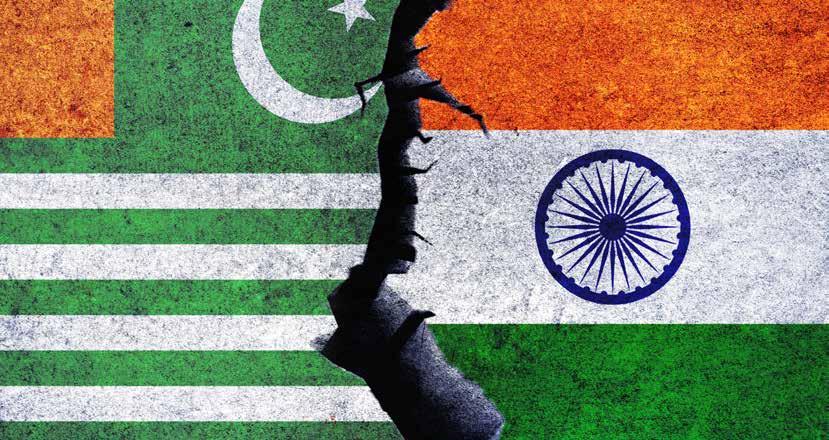
In a planet earth that has already been the scene of two protracted armed conflicts with extremely serious repercussions, in terms of the number of innocent civilian victims, the extent of material destruction, the precariousness of geo-strategic balances and barriers of hatred between the belligerents that are difficult to remove even after the hoped-for cease-fires, a third geographical area of crisis has recently made its threatening appearance on the international scene, foreshadowing new and equally damaging consequences.
This is the dispute between India and Pakistan, which has come dramatically back under the spotlight after the recent massacre perpetrated by Islamic terrorists in Kashmir (an area that has always been disputed between the two states) in which some 30 Indian citizens died. The tragic episode was immediately followed by military reprisals ordered by the New Delhi government to punish the attackers and their instigators, identified, rightly or wrongly, in the Pakistani secret services. In a region plagued by endemic violence for several decades, this is unfortunately not unprecedented, but the particularly cruel nature of the executions has impressed all ‘insiders’.
For those unfamiliar with the very strong contrasts, especially religious ones (often presented as a ‘clash of civilisations’ between Hinduism and Islam), that characterise that geographical area, it may seem surprising how an objectively positive event such as the liberation from the British colonial empire in the immediate aftermath of the Second World War led the two newly independent states to fight each other incessantly from the year of their creation in 1947.
Coming to the present day, even a superficial analysis of the two ‘contenders’ reveals power relations that are far from homogeneous, starting with an Indian population about six times larger than that of Pakistan, with related reflections in the size of their respective armies. The assessment of the two economic systems also leads to a similar imbalance, with Delhi ranking fourth in the world gross domestic product and Islamabad unable to attract foreign investment other than Chinese investment, on which it is now largely dependent.
It should also be considered that, despite its imperfections, the Indian political system (which in recent years has notably drawn closer to the United States, partly thanks to Modi’s leadership) is fundamentally democratic, ensuring, for example, the integrity of electoral processes. This regularly results in changes of leadership in the country’s highest offices, both at the central and regional levels (for further details, see issue 29 of ‘La Voce di Maria Dolens’). None of this applies to the neighbouring country, dominated by a regime in which the worst features of militarism and radical Islamism are assimilated, after the brief season in which an alignment with the United States seemed to take shape, motivated at first by the objective of countering the Soviet occupation in neighbouring Afghanistan and later by the fight against Taliban fundamentalism.
The combination of these differences, which would tip the scales in one clear direction, is however ‘offset’ by the realisation that both states possess nuclear weapons, with potentially devastating consequences far beyond their regional spheres. Since, fortunately, neither capital appears capable of initiating such an ‘escalation’ and sustaining the political consequences, less lethal but undoubtedly invasive measures are deemed practicable, such as, for example, the so-called ‘water war’, which India could resort to by diverting the course of rivers essential for the survival of the Pakistani population.
In conclusion, were it not enough to place the United States and China in diametrically opposed positions, the great unknown linked to the future of Taiwan and the fluctuating issue of tariffs (a dossier where, moreover, positive steps forward in reaching an understanding have recently been recorded), the Indo-Pakistani dispute could represent a new scenario of conflict between the two world superpowers.
Here again, we are certainly not the only ones who would like to see the international community intervene in a mediating role, thus preventing the wound from being further aggravated instead of healed. A slither of
29 MAY 2024 - 29 MAY 2025
Exactly one year ago, Sen. Prof. Alberto Robol left us, at the end of a life of great industriousness, divided between authoritative political commitment and generous activity in favour of the Campana dei Caduti Foundation, of which he was President for no less than 17 years (from 2003 to 2020).
Among the many initiatives that marked his fruitful tenure, two stand out for their extraordinary significance: the construction of the current prestigious headquarters on Miravalle Hill — whose Auditorium has been dedicated to his memory since last year — and the strengthening of the Foundation’s international vocation, which led to the formal recognition of its status by the Council of Europe (2006) and the United Nations (2009).
By an arbitrary and unfair twist of fate, the Foundation was deprived of the very important intellectual, moral and spiritual contribution of its former President on the
hope stems from the initiative of US President Donald Trump, who instructed Secretary of State Rubio to engage in negotiations. This appears, objectively, to be a sign in the right direction, especially if some influential Arab country (Oman, Saudi Arabia or others) is willing to join the negotiation efforts.
Reggente Marco Marsilli, Foundation President
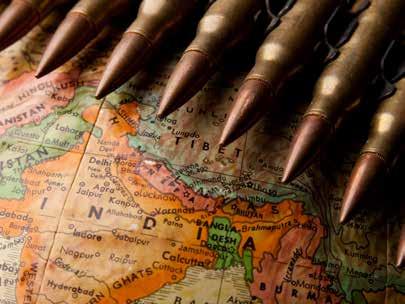
very eve of the centenary celebrations of Maria Dolens, but this circumstance does not, on an ideal level, diminish the sense of his enduring and constant presence by our side.
Together with all the members of the current Presidency Council and the Foundation staff, I would like to reiterate to Sen. Prof. Alberto Robol’s the feelings of undying closeness and the desire to share a memory of him marked by affection, esteem, and gratitude.

The Archivio Disarmo International Research Institute recently published in its journal ‘IRIAD Review. Studi sulla Pace e sui conflitti’ (Peace and Conflict Studies) an in-depth look at the world’s nuclear weapons from a report by the Federation of American scientists. We are pleased to republish the illustrations here, and thank the experts of Archivio Disarmo for their collaboration.
Despite the progress made in reducing nuclear arsenals since the end of the Cold War, the total number of nuclear warheads in the world remains extremely high. At the beginning of 2025, nine countries held a total of 12,331 warheads. According to a study by the Federation of American scientists, this is a kind of ‘atomic duopoly’. The US and Russia together hold about 88% of the world’s nuclear inventory and 84% of the stockpiled warheads available to the armed forces. The rest of the atomic armament is scattered all over the planet. With the exception of Washington and Moscow, no nuclear-armed government considers it necessary to possess more than a few hundred warheads for national security, although in many cases arsenals are growing.
Globally, the overall number of nuclear weapons is declining, but the pace of reductions is much slower than in the last 30 years. The drop in absolute value is mainly due to the fact that the US and Russia continue to dismantle previously withdrawn warheads. In contrast to this trend, the number of warheads in the military arsenals - i.e. those assigned to operational forceshas risen again. While the US is slowly reducing its arsenal, France and Israel keep their arsenals relatively stable. On the contrary, China, India, North Korea, Pakistan, the United Kingdom, and possibly Russia, seem to be in the process of strengthening their stocks.
According to the study, updated to March 2025, of the world’s 12,331 nuclear warheads, some 9,604 are in
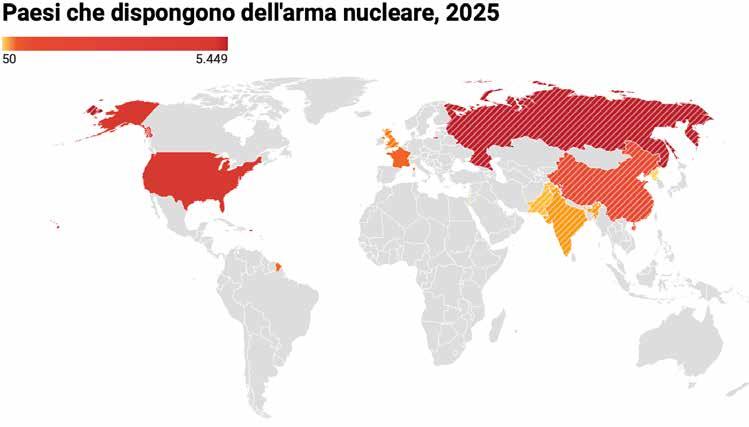

Withdrawn
Stock / undeployed
Non-strategic deployments
Strategic deployments
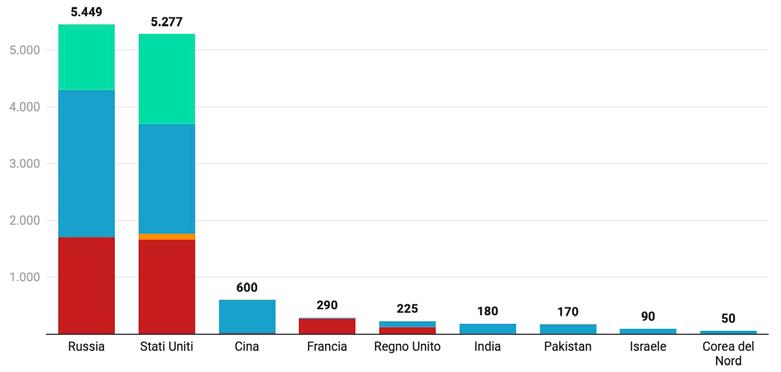
military arsenals, ready for use on missiles, aircraft, ships or submarines. The remaining 2,727 were withdrawn, but remain intact pending dismantling. Of the 9,604 still operational, some 3,904 are deployed with forces operating in the field. Of these, more than 2,000 (US, Russian, British and French) are on high alert and ready for immediate use.
However, the exact number of nuclear warheads possessed by each country cannot be precisely defined, as it is protected by state secrecy. The available estimates, the experts point out, are based on independent analyses, public data, historical documents and occasional leaks. Transparency varies widely from country to country.
To give just a few examples, suffice it to say that between 2010 and 2018, the United States disclosed the size of its arsenal, but the administration led by Donald Trump stopped this practice in 2019. Upon arriving at the White House, Joe Biden restored it briefly in 2020, only to suspend the publication of data in 2021, 2022 and 2023. In 2021, the UK also announced that it would no longer publish data on its operational ar-
senal. Finally, in 2023, the United States and Russia stopped exchanging public data on deployed strategic warheads, as was stipulated in the New Start treaty.
From a historical perspective, it can be said that the quantity of nuclear weapons has decreased dramatically since the peak of around 70,300 warheads in 1986. However, the pace of reduction has slowed considerably since the 1990s and today relies almost exclusively on the decommissioning of retired warheads.
Contrary to the Nuclear Non-Proliferation Treaty (NPT), nuclear-weapon states seem intent on maintaining significant arsenals indefinitely. All continue to modernise their armaments, some are introducing new types of ordnance, and are expanding the role of nuclear power in their military strategy and public communication.
The estimates presented were prepared by Hans M. Kristensen, Matt Korda, Eliana Johns and Mackenzie Knight of the Federation of American Scientists, based on the work of Thomas Cochran, Robert Norris and William Arkin.
To be continued from page 1...
Then it’s time to put on a headset, adjust the microphone, join our colleagues and go live to describe the incredible sight before us: tens of thousands of people gathering after having seen or heard of the “white smoke”—a centuries-old method that continues to announce the same event, always new and ancient at once: the election of the Pope. Time appears to slow down, the wait is nearly over. He will soon appear. The director ‘intimates’ to continue talking until the fateful moment. Suddenly there is silence. ‘Annuntio vobis gaudium magnum; habemus Papam: Eminentissimum ac Reverendissimum Dominum Robertum Franciscum Sanctae Romanae Ecclesiae Cardinalem Prevost, qui sibi nomen imposuit Leonem Decimum Quartum’.
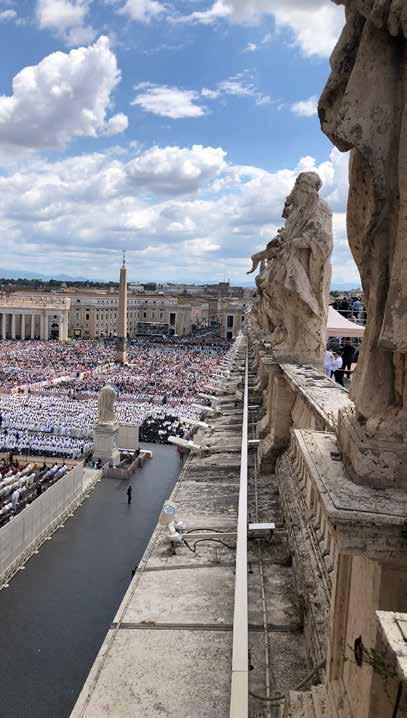
Leo XIV. The name is the first choice a Pope makes, so to understand which way the universal Church is headed, we start by looking at how his closest predecessor with the same name acted. Leo XIII was the Pope of Rerum Novarum, which can be translated into English as ‘Of new things’, a pillar of the Church’s social doctrine. “It can’t be an accident,” thinks the reporter with the headset, and he says so, but it’s time to be quiet again, it’s time for the blessing: ‘Peace be with you all! Dear brothers and sisters, these are the first words spoken by the risen Christ, the Good Shepherd who laid down His life for God’s flock. I would like this greeting of peace to resound in your hearts, in your families, among all people, wherever they may be, in every nation and throughout the world. Peace be with you! It is the peace of the risen Christ. A peace that is unarmed and disarming, humble and persevering’.
The word Peace already appears five times at the beginning of the greeting. This cannot be an accident either. Not only that, Peace must be ‘disarmed’ and ‘disarming’ and already this begins to be a clear indication. Robert Francis Prevost, dual US and Peruvian citizenship, the second Pontiff from the American continent, the first from the United States of America, the first belonging to the Order of St Augustine, 70 years old next 14 September, seems to be going in a precise direction: building bridges with dialogue and encounters between peoples.
The window of the loggia closes, the people start to evacuate, hundreds of journalists and photographers from all over the world put their notebooks away, switch off their computers, dismantle lenses as long as those in spy films, descend in the lift and go back to covering the usual news, the kind that fills the newspapers on the days when a Pope has not just died or another has not just been elected. Meanwhile, Vatican diplomacy is back at work, just as it was quietly active on the sidelines of Francis’s funeral — without much fanfare, as is typical of seasoned diplomats who know how to operate.
The ‘noise’, instead, comes from the words spoken by Leo XIV a few days later in Paul VI Hall. It is not far from Charlemagne’s arm — it lies lower, on the ground, with no need to get into a shaky lift to reach it — yet despite the ease of access, here the media pay less attention to noticing the details. The event is over, the world’s greats have gone home. Sometimes the facts of history are read as if they were a show, the result being that after the credits few people verify what happens after the adverts.
Leo XIV meanwhile held his first general audience on 21 May. Before greeting those present, he launched a humanitarian appeal, recalling the “increasingly worrying” situation in the Gaza Strip, where the attacks are still
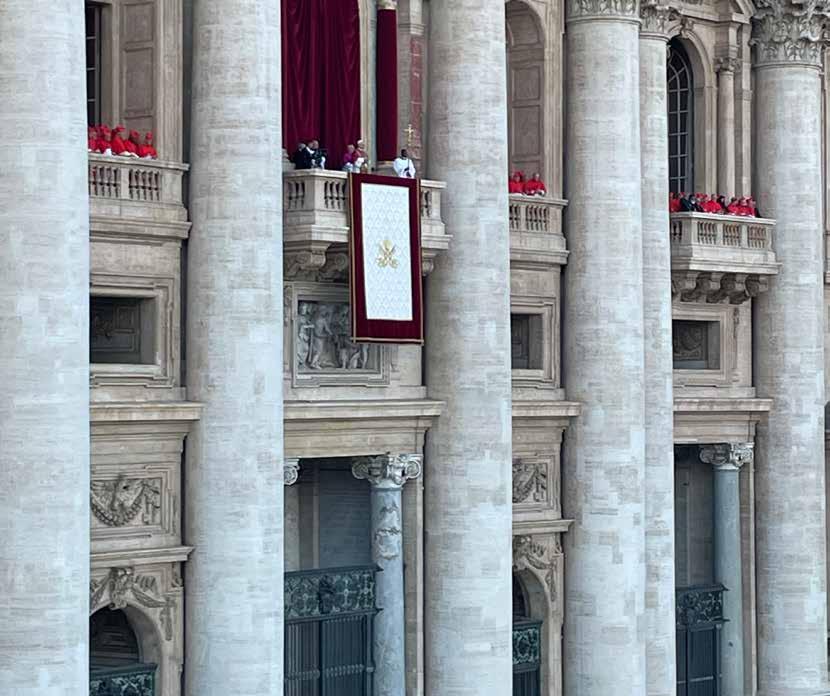
ongoing and people are dying due to the lack of food. Prevost calls for the ‘entry of dignified humanitarian aid’ and invites all believers to disarm ‘their hearts’. But that’s not enough — certain things had already been said in the very places meant for mediation, in multilateral institutions that may be subject to criticism and certainly open to improvement, but whose absence would carry serious risks.
The centre of world diplomacy should be, and perhaps is not enough, the United Nations building in New York, and it was there that the Secretary of State, Cardinal Pietro Parolin, went on 19 May to clarify what the strategy of the new pontificate will be. Under the guidance of Leo XIV, the Holy See is committed to working alongside the representatives of nations ‘to promote human dignity, protect the vulnerable, and build bridges where mistrust might otherwise prevail,’ said the cardinal in a speech delivered at the United Nations Headquarters during a reception hosted by the Holy See’s Permanent Observer, Archbishop Gabriele Caccia. The choice of a
new Pontiff is an opportunity “The election of a new Pope is an occasion of renewal, not only for Catholics, but for all who seek a world of greater justice, solidarity, and peace”, he added, hoping that the Holy See and the representatives of the nations can move “forward together, inspired by the hope and vision of Pope Leo”, who already “in his first days as Successor of Peter, expressed his deep commitment to building bridges, emphasising the need to meet, dialogue and negotiate”. In a world ‘marked by divisions, conflicts and pressing global problems - from climate change to migration to artificial intelligence’, the Pope ‘calls us to embrace a diplomacy of encounter, which listens with humility, acts with compassion and seeks the common good above all else’, Parolin concluded.
It seems clear, then, that the name he chose, his first words, and everything Leo XIV has communicated so far all point toward Peace — a Peace to be built, not merely awaited.
mf
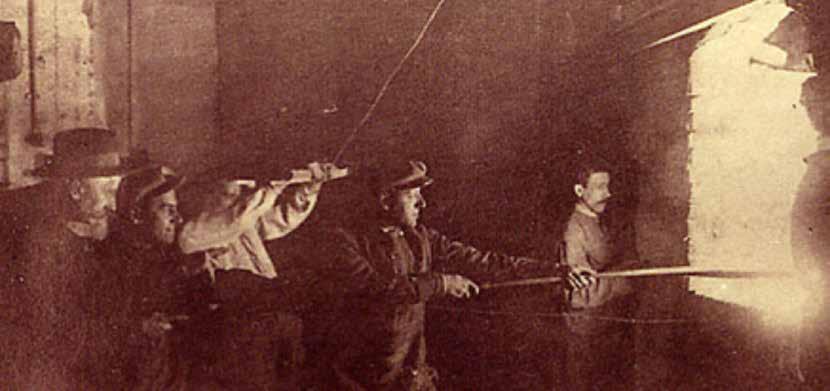
FOR WHOM THE BELL TOLLS - P 18
You cannot call a place for Peace ‘Valscodella’, it does not work. That is why when the Presidency unanimously decided on 7 June 1962 to purchase land to relocate the Bell, it changed the name of the area to Miravalle. The space was, and still is, on the slopes of the Castel Dante hill. A symbolic and strategic choice that marked the desire to renew the mission of Maria Dolens, moving her away from the Malipiero bastion, where she had originally been placed. The municipal council approved the transfer of the land on 23 October, at the same time as contacts were initiated with the province for a new road access. The news sparked controversy. Some saw the move as a betrayal of the original project of Don Antonio Rossaro, who had wanted the Bell in the heart of the city. But the urban context had changed: Rovereto
had expanded, Miravalle no longer appeared as a peripheral location and seemed an ideal space to host international events.
Father Iori strongly defended the new vision: a ‘Piazzale delle Genti’ was to be created, a space open to the encounter of peoples, a symbolic place for Peace and brotherhood. Not without some discontent, don Rossaro’s family also supported the change. Renato, the founder’s nephew, stated in a statement in March 1961 that the Presidency’s work was a natural evolution of his uncle’s thinking. But the opposition did not subside. In 1965, a ‘Committee of Gratitude to Don Rossaro’ was even formed, denouncing the move as a disrespectful act.
The Presidency responded with a public statement, reaffirming the legitimacy of its actions.
After all, the members of the governing body of the Bell were appointed by the founder himself, and no document bound Maria Dolens to a fixed location. The controversy did not subside, there was only one way to cover up that background noise, to go back and listen to Maria Dolens’ voice, which had remained silent for too long. On 1 October 1964, the third casting took place at the Capanni foundry in Castelnuovo. The bronze was poured into the mould in complete silence; there had been too many disappointments in the past. At the end of the process, a bronze giant emerged, weighing 22,639 kilograms, with a height and diameter of 3.36 and 3.21 meters respectively, a clapper weighing 600 kilograms, and a yoke of 10,300 kilograms. The new Bell was born, the largest bell in the world rung out in the open air. Made with the original bas-reliefs by Stefano Zuech, the Maria Dolens had a more sober appearance than its predecessors: with the internal inscriptions removed, only the words of Pius XII and John XXIII remained alongside the poetic verses engraved by the foundryman.
A new era had begun, ours.